Problem V PART A By way of a well crafted essay response ple
Problem V
PART A: By way of a well crafted essay response, please define and explain (to include your own examples) the Theory of Reasoned Action, the Theory of Planned Behavior and the Technology Acceptance Model (10 points).I want a fluid story not three distinct paragraphs. Connect the dots, how did we go from the Theory of Reasoned Action to the Technology Acceptance Model?
PART B: A U.K. –based travel agent, Tony Blair, LLC would like your systems team to design a command-language interface he can use to book seats for airliners to which his firm has solid business ties, such as British Air, Ryan Air, and Virgin-Atlantic.
Make a list of commands needed to book an airline seat and write down what each command means. (15 points)
Show what the interface would look like on a smartphone display.
Solution
1-An information systems theory that models how users come to accept and use a technology.
2-A model developed to study the acceptance of the technology by an individual taking into account, basically, both the perceived easy of use and the usefulness of the technology.
3-The TAM was initially proposed by Davis (1989). It comprises two beliefs, the perceived utilities and the perceived ease of application, which determine attitudes to adopt new technologies. The attitude toward adoption will decide about the adopter’s positive or negative behavior in the future concerning new technology.
4-Was developed by Davis (1993) and theorized that attitude toward using technology is a function of two beliefs: perceived usefulness and perceived ease of use.
5-One of the most frequently employed models for research into new information technology acceptance. The TAM suggests that when users are presented with a new technology, a number of factors determine their decision about how and when they will use it.
6-This is a theoretical framework designed by Davis (1989) that proposes a relationship between users’ acceptance of a new IS and the users’ perceptions of the ease of use and usefulness of the IS.
7-TAM is a model of user acceptance of information systems technology based on the theory of reasoned action. Two variables perceived usefulness and perceived ease of use lead to attitude toward use, behavioral intention to use and use of the system.
Part-B:
import java.awt.event.*;
import javax.swing.table.*;
import javax.swing.*;
import java.awt.*;
import java.sql.*;
import java.util.*;
public class CheckAvailability extends JDialog implements ActionListener,FocusListener,KeyListener
{
private JTextField t1,t2,t3;
private JButton b1, b2;
private JComboBox cb0, cb1, cb2, cb3;
private DefaultTableModel dfm;
private int key;
private Dimension d = Toolkit.getDefaultToolkit().getScreenSize();
public CheckAvailability(JFrame f,String str,Boolean b,String dd)
{
super(f,str,b);
JLabel l_logo = new JLabel(\"Tiger Airlines\");
JLabel l_heading = new JLabel(\"Check Availability\");
setSize (500, 250);
setLocation (d.width / 2 - getWidth() / 2, d.height / 2 - getHeight() / 2);
JLabel l1 = new JLabel(\"Flight No.: \");
JLabel l2 = new JLabel(\"Travel Date: Day\");
JLabel l3 = new JLabel(\"Month\");
JLabel l4 = new JLabel(\"Year\");
JLabel l5 = new JLabel(\"First Class Seats:\");
JLabel l6 = new JLabel(\"Business Class Seats:\");
JLabel l7 = new JLabel(\"Economy Class Seats:\");
String []fln1={\"1\",\"2\",\"3\",\"4\",\"5\",\"6\",\"7\",\"8\",\"9\",\"10\",\"11\",\"12\",\"13\",\"14\",\"15\",\"16\",
\"17\",\"18\",\"19\",\"20\",\"21\",\"22\",\"23\",\"24\",\"25\",\"26\",\"27\",\"28\",\"29\",\"30\",\"31\"};
cb0 = new JComboBox(fln1);
\\
ArrayList arr = obj.CheckAvailability((String)cb0.getSelectedItem(),(String)cb1.getSelectedItem()+\" \"+(String)cb2.getSelectedItem()+\" \"+(String)cb3.getSelectedItem(),\"First\");
if(arr.size()<100)
{
int a = 100-arr.size();
t1.setText(String.valueOf(a));
}
else
t1.setText(\"0\");
Db obj1 = new Db();
ArrayList arr1 = obj1.CheckAvailability((String)cb0.getSelectedItem(),(String)cb1.getSelectedItem()+\" \"+(String)cb2.getSelectedItem()+\" \"+(String)cb3.getSelectedItem(),\"Business\");
if(arr1.size()<=100)
{
int a = 100-arr1.size();
t2.setText(String.valueOf(a));
}
else
t2.setText(\"0\");
Db obj2 = new Db();
ArrayList arr2 = obj2.CheckAvailability((String)cb0.getSelectedItem(),(String)cb1.getSelectedItem()+\" \"+(String)cb2.getSelectedItem()+\" \"+(String)cb3.getSelectedItem(),\"Economy\");
if(arr2.size()<=100)
{
int a = 100-arr2.size();
t3.setText(String.valueOf(a));
}
else
t3.setText(\"0\");
}
}
public void focusGained(FocusEvent e)
{
if(e.getSource()==b1)
key = 1;
}
public void focusLost(FocusEvent e)
{
{
int a = 100-arr.size();
t1.setText(String.valueOf(a));
}
else
t1.setText(\"0\");
Db obj1 = new Db();
ArrayList arr1 = obj1.CheckAvailability((String)cb0.getSelectedItem(),(String)cb1.getSelectedItem()+\" \"+(String)cb2.getSelectedItem()+\" \"+(String)cb3.getSelectedItem(),\"Business\");
if(arr1.size()<=100)
{
int a = 100-arr1.size();
t1.setText(String.valueOf(a));
}
else
t2.setText(\"0\");
Db obj2 = new Db();
ArrayList arr2 = obj2.CheckAvailability((String)cb0.getSelectedItem(),(String)cb1.getSelectedItem()+\" \"+(String)cb2.getSelectedItem()+\" \"+(String)cb3.getSelectedItem(),\"Economy\");
if(arr2.size()<=100)
{
int a = 100-arr2.size();
t1.setText(String.valueOf(a));
}
else
t3.setText(\"0\");
}
}
public void keyReleased(KeyEvent e)
{
}
public void keyTyped(KeyEvent e)
{
char c = e.getKeyChar();
if(e.getSource()==t1 || e.getSource()==t2 || e.getSource()==t3)
{
getToolkit().beep();
e.consume();
}
}
}
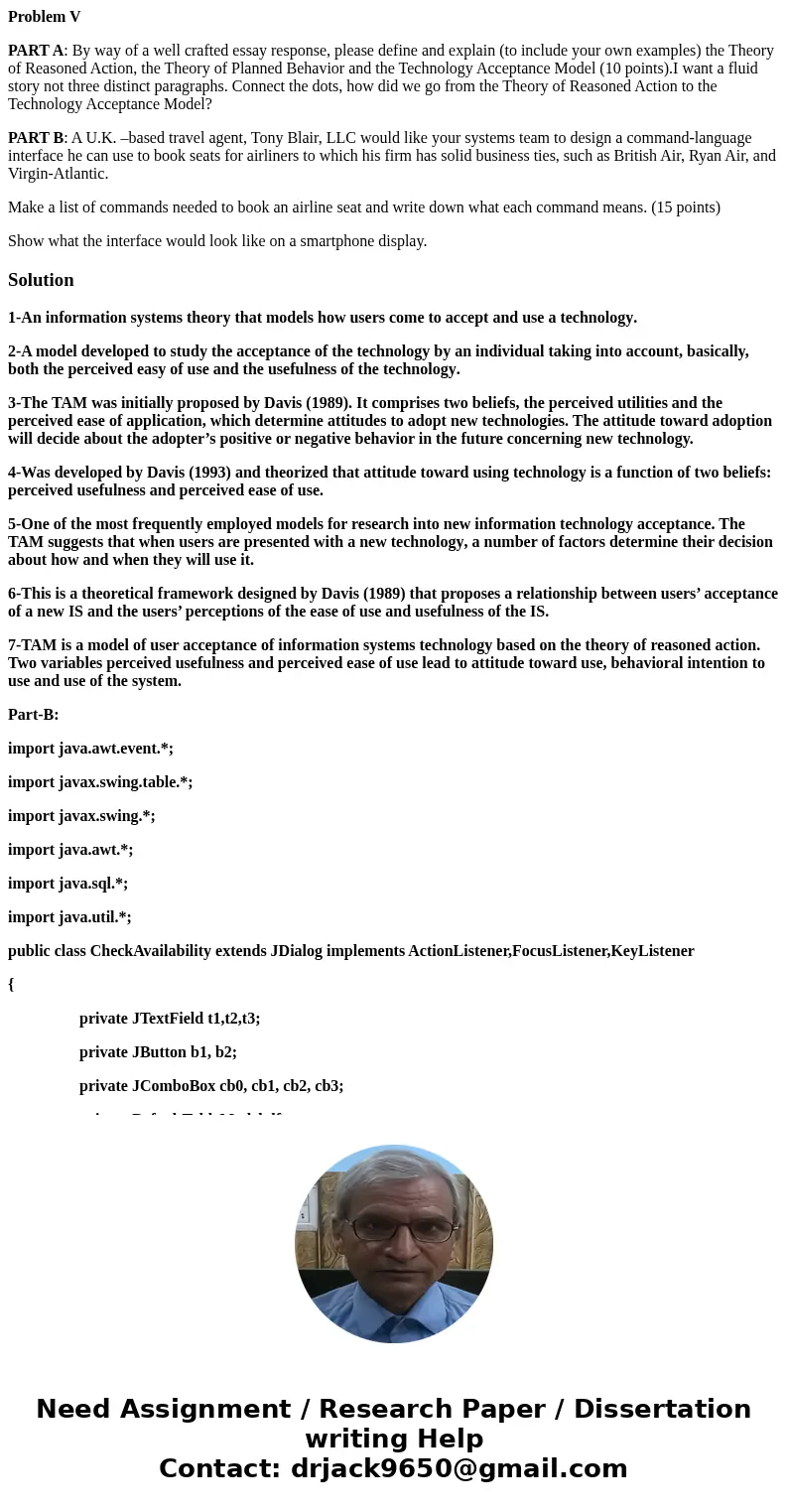
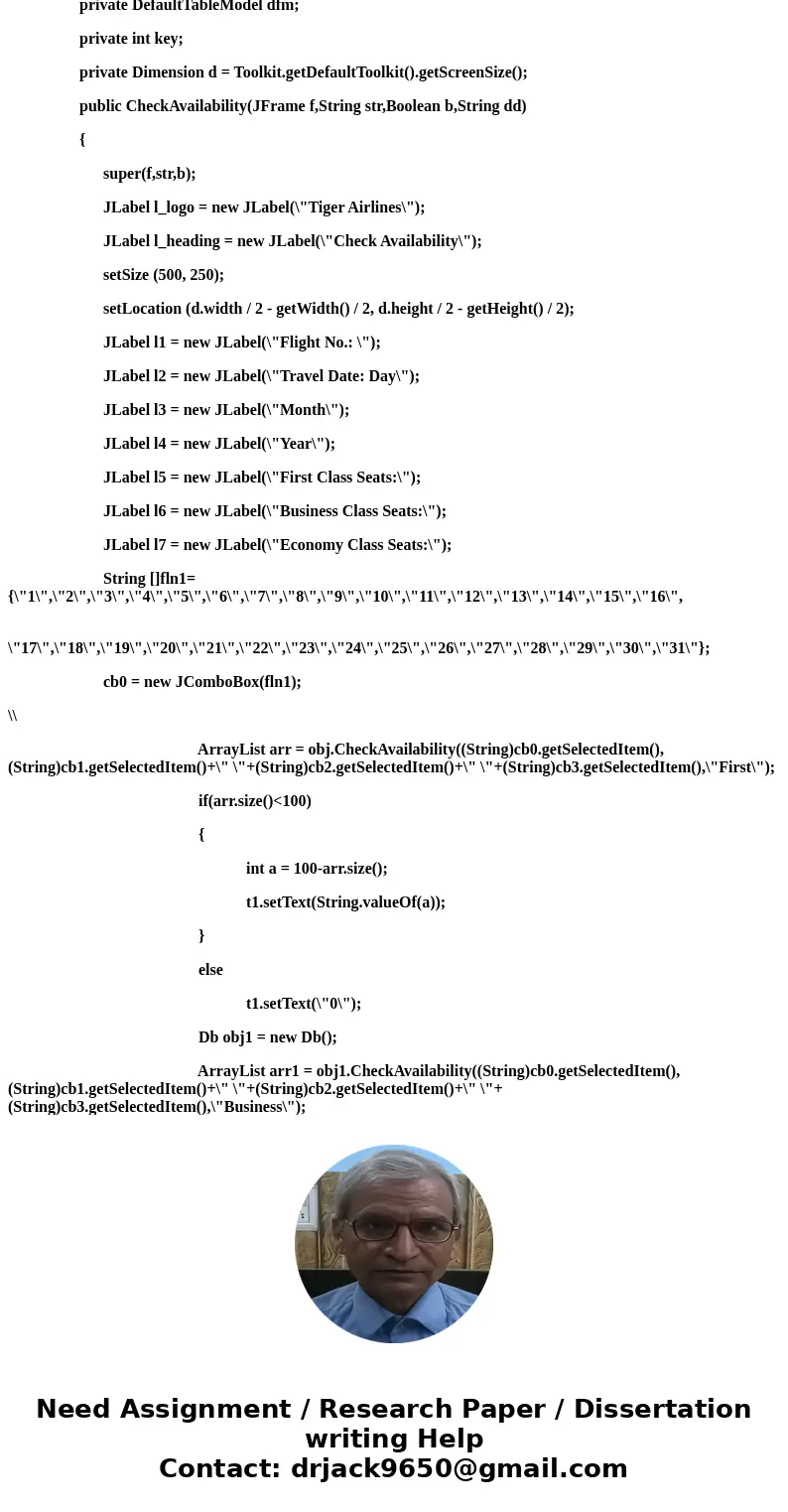
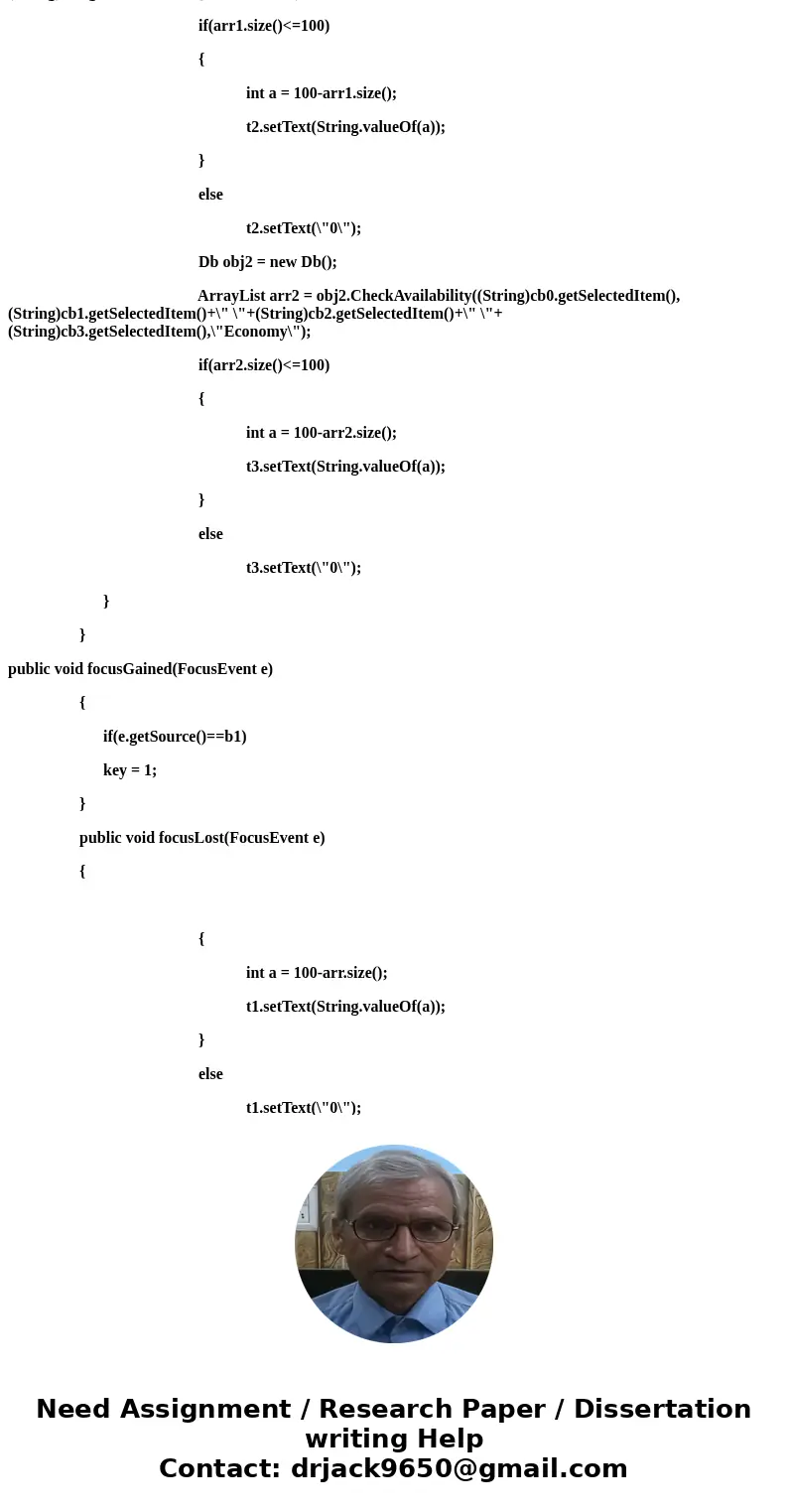
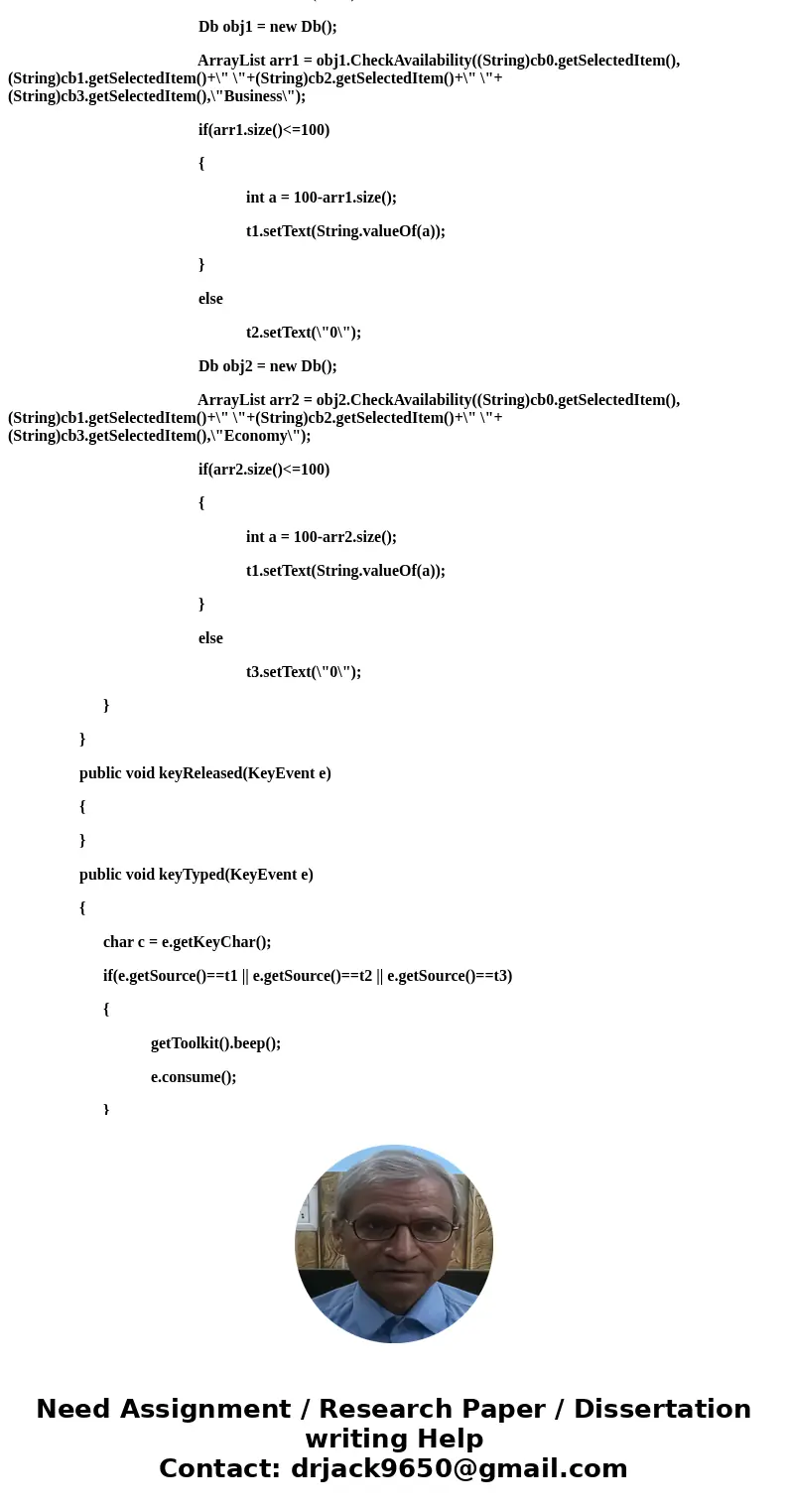
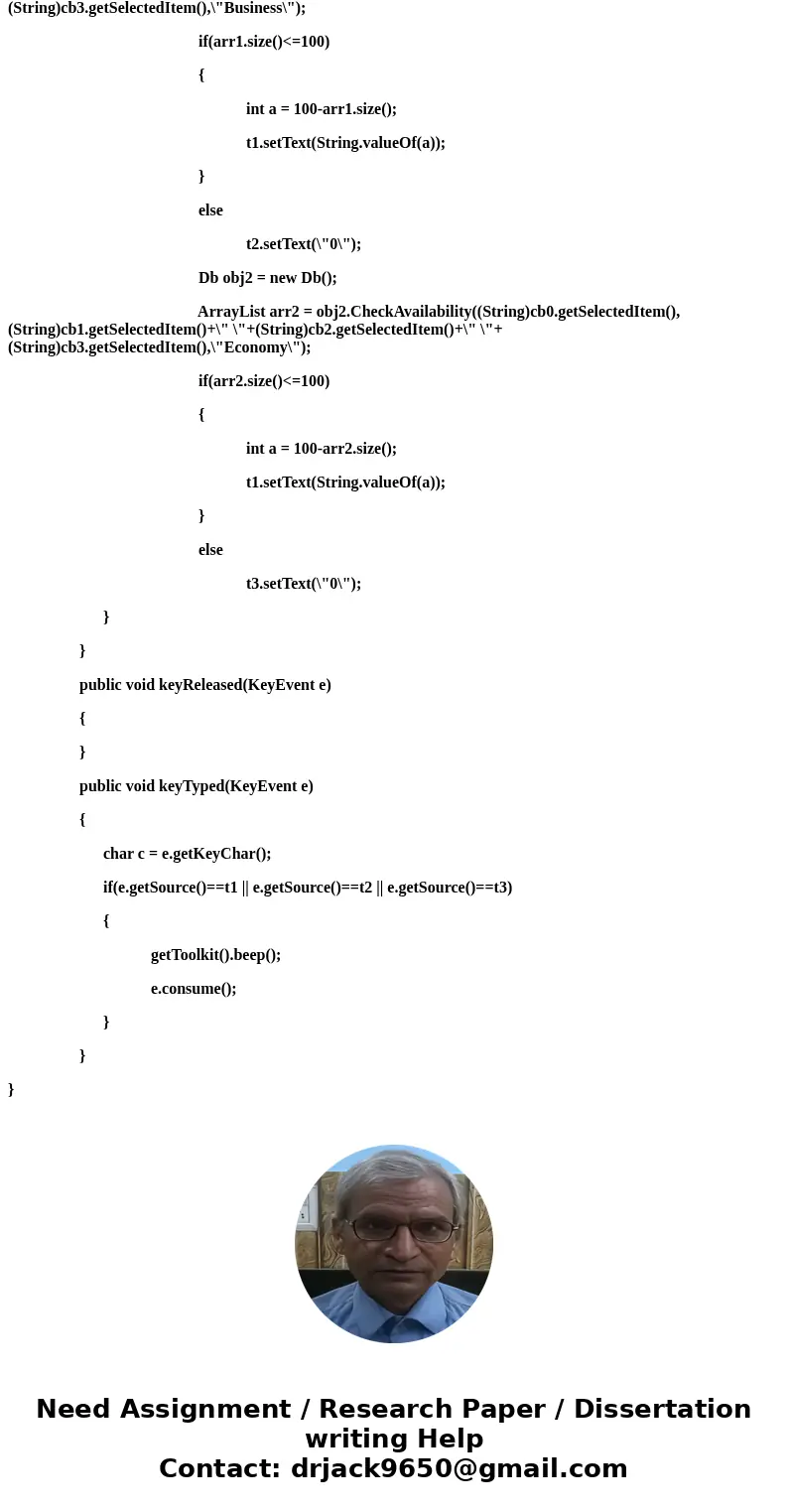
 Homework Sourse
Homework Sourse